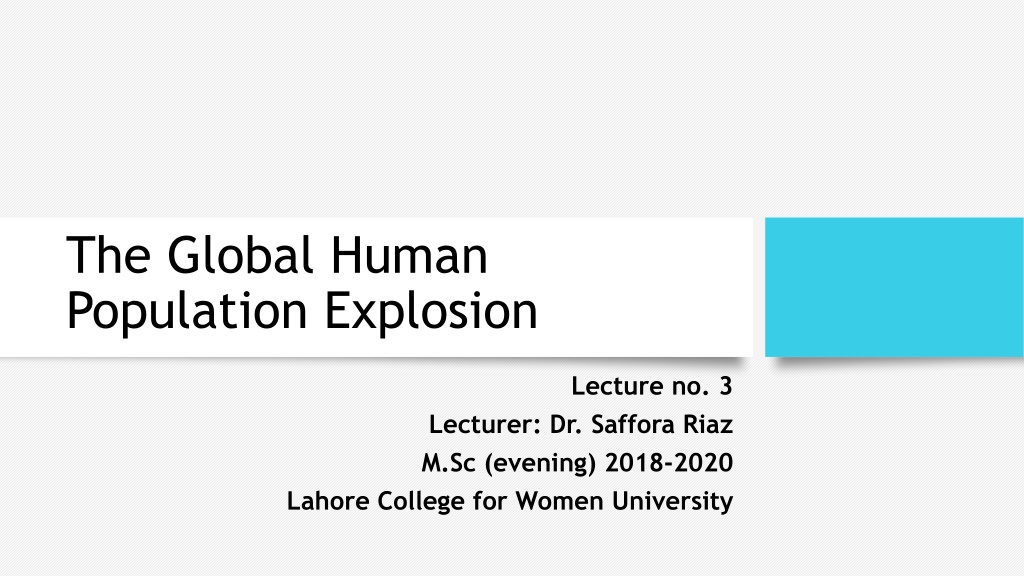The Global Human Population Explosion: Causes and Implications
The lecture explores the rapid increase in the global human population post-World War II, analyzing factors such as birth rates, mortality rates, and life expectancy. Various counterarguments are presented, including the debate on population growth benefits, ethical concerns over reproductive interference, the focus on consumption rather than population, and the belief in natural population leveling off. Moreover, concerns about population control programs as a form of social engineering are highlighted.
Download Presentation

Please find below an Image/Link to download the presentation.
The content on the website is provided AS IS for your information and personal use only. It may not be sold, licensed, or shared on other websites without obtaining consent from the author. Download presentation by click this link. If you encounter any issues during the download, it is possible that the publisher has removed the file from their server.
E N D
Presentation Transcript
The Global Human Population Explosion Lecture no. 3 Lecturer: Dr. Saffora Riaz M.Sc (evening) 2018-2020 Lahore College for Women University
DEFINITION: The rapid increase in numbers of a particular species, especially in the world's human population since the end of World War II, attributed to an accelerating birthrate, a decrease in infant mortality, and an increase in life expectancy.
Major Counterarguments: 1. Some claims that population growth is beneficial in that more people provide more ideas, creativity and work. Supported by the fact that greatest technological advance and improvements in living standards
2. Some claims that any artificial interference in the reproductive process( include sex education, contraceptives and especially abortions.) is immoral Therefore, for them any thought of altering the cause of population growth is not debatable.
3. Some argue that population is not the issue as much as consumption is, at least for the present. What needs to be achieved more than reducing growth in numbers they say, is adopting conservation measures that will reduce consumption.
4. Other take the position that population growth will level off by itself well within the capacity to support the population. Supported by the fact that we have been able to expand agricultural production even faster than population growth and that the average no of birth per women is coming down.
Still others are disturbed by the fact that population programs often seem to have the trappings of social engineering the rich trying to get rid of the poor or minorities by preventing them from having children.
Reason for the Explosion The main reason for slow and fluctating population growth piror to the early 1800s was: 1. Prevalence of Diseases 2. Epidemics of Diseases 3. Famines also were not unusual.
Biologically The population was essentially in a dynamic balance with natural enemies-mainly diseases-and other aspects of environmental resistance. High reproductive rates were largely balanced by high mortality, especially among infants and childeren
Average Fertility Rate The average fertility rate-that is , the average number of babies born to a woman over her lifetime-has declined, resulting in a decreasing rate of growth of population
Different Worlds Rich Nations The World Bank, an arm of the United Nations, divide the countries of the world into three main economics categories: 1. High-income, highly developed, industrialized countries 2. Middle-income, moderately developed countries 3. Rich-income countries
Developed countries The high-income nations are commonly referred to as developed. countries Developing countries Whereas the middle- and low- income countries to as developing.
Population growth in rich and poor nation Total fertility rate: Average no of children each woman has over her lifetime. Replacment factor: That fertility rate which will just replaced the population of parents
Different population present different problems Environmental regard: Environmental impacts of affluent lifestyle may be moderated to a large extent by a factor we call environmental regard Negative population size Environmental = __________________________________________ Impact environmental regard consumptiveness of lifestyle
Environmental and social impacts on growing populations Five basic alternatives are possible all of which are being played out various degrees by people in these societies 1. Subdivide farms among the children of the next generation and/or intensify cultivation of existing and to increase production per unit area. 2. Open up new land to farm.
3. Move to cities and seek employment. 4. Engage in illicit activities for income. Illicit drugs Poaching of wildlife 5. Emigrate to other countries legally or illegally. 6. Impoverished women and children.
Dynamics of population growth Population profile: A population profile is a bar graph showing the no of people (males and females separately)at each age for a given population. Demography : The field of collecting, compiling, and presenting information about populations is called demography
Population projections Most significantly we can use a population profile and certain others data to estimate the future over all growth of a population The forecasting technique: The technique of estimating future population growth of (or decline) is one of estimating numbers of future births and deaths.
Demographic Transition: The gradual shift from the primitive to the modern condition that is correlated with development is called demographic transition. The Crude Birth Rate (CBR)and Crude Death Rate(CDR) : these term are define as the no of births or deaths per 1000 of population per year. CBD CDR natural increase no of births _ no of deaths = (or decrease) in per 1000 per 1000 population per 1000 per year per year per year
Demographic transition (4 phases) Phase 1 Primitive stability high CBR offset equally by high CDR Phase 2 Declining CDR reduction of infants and high mortality Phase 3 Declining CBR reduction in fertility rate Phase 4 Modern stability low CDR but an equal low CBR

